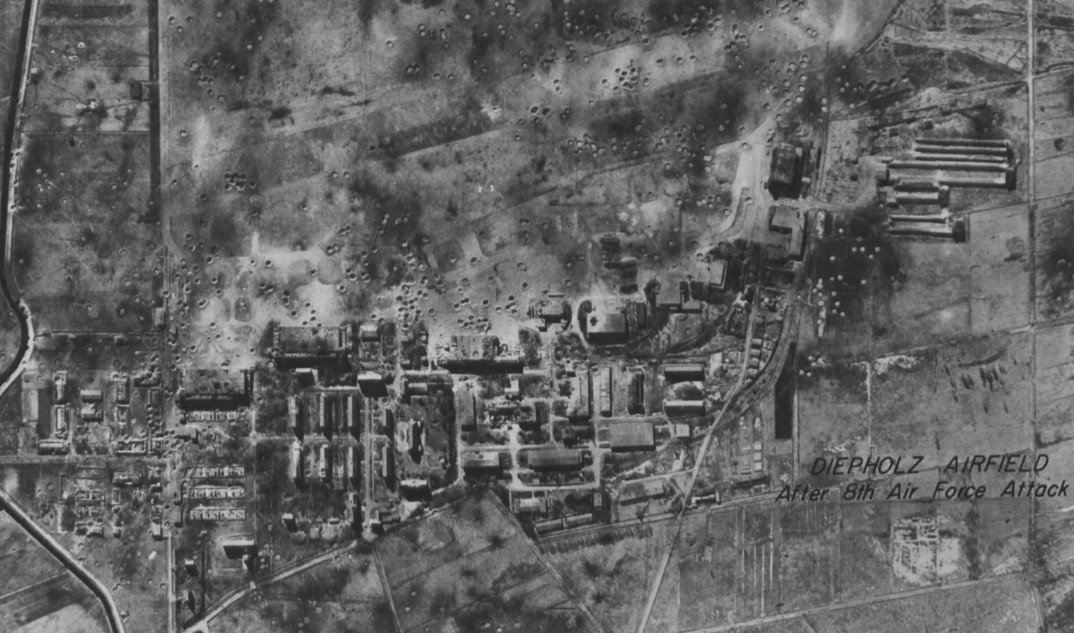Diepholz Germany
Mission Summaries > February 1944 > Airfields in Feb 44
Diepholz (GER)
(52 35 15 N – 08 20 45 E)
General: airfield (Fliegerhorst) 42 km NNE of Osnabruck in Lower Saxony and 2.8 km SSW of Diepholz.
History: construction began in fall 1934 and was carried out by Luftwaffe construction troops and the Reichsarbeitsdienst. Luftwaffe Fliegerhorstkommandantur by fall 1935. A Luftpark (air park) was located there since March 1936 and the first flying unit arrived in 1937. Used by bomber units to 1941, by a transport unit in 1942 and then by night fighters toward the end of the war.
Dimensions: approx. 1070 x 860 meters (1,170 x 940 yards).
Runway: had 1 paved runway measuring c. 1,070 meters, a ladder-type servicing tarmac running along the length of the N boundary in front of the hangar area and a paved taxiway. Night landing facilities.
Infrastructure: fuel, refueling points, water, ammunition, communications, compass swing, machine gun registration range and other amenities were available. Had 2 large, 3 medium and 2 small hangars with tarmac aprons along the N boundary, adjacent workshops and a motor pool with garages. Blocks of numerous storage buildings were located to the W, N and NE of the airfield, these dating to the period when Diepholz was home to a Luftpark. Admin buildings were behind the hangar area and a large barrack block at the NE corner. Munitions dumps at the NW and SW corners. A special branch rail line serviced the airfield.
Dispersal: in 1941 there were 3 dispersal areas with at least 34 open aircraft shelters.
Defenses: 2 large concrete Flak positions, one on a hillock 6 km to the NE near the village of Sankt Hulfe and the other 3 km SE of the airfield.
Satellites and Decoys:
Diepholz – Heeder Moor (GER)(53 37 30 N – 98 19 30 E)Dummy 11.3 km SSE of Vechta airfield and 4.5 km NW of Diepholz airfield. Mock-up included 3 dummy hangars with aprons and 9 small dummy buildings on the S boundary with decoy lighting surrounding the perimeter.
Remarks:
1940-43: attacked 13 times by a few aircraft at a time with very little damage resulting. USAAF attacks on 21 Feb 44 and 30 May 44 destroyed the runway, runway drainage system and the hangars, and the repair work required many weeks with a maximum expenditure of labor and resources, according to a Luftgaukdo. XI report.
21 Feb 44: bombed – 1 x Fw 44 and 2 x He 177 A-1s from Erprobungskommando 25 destroyed or damaged on the ground.
30 May 44: destroyed the runway, runway drainage system and the hangars, and the repair work required many weeks with a maximum expenditure of labor and resources, according to a Luftgaukdo. XI report.
06 Apr 45: captured by British troops and then used by the RAF for a short while.
Operational Units: III./KG 254 (Apr 37 – Mar 38); II./KG 4 (Dec 39 – Feb 40); III./JG 27 (Nov 40); KGr. z.b.V. 5 (May-Jul 42); KGr. z.b.V.106 (Nov 42 - Mar 43); KGr. z.b.V. 23 (Apr 43); Stab/TG 2 (Aug-Sep 43); Stab, I./TG 1 (c. Aug-Oct 43).
School Units: Arbeitsplatz (Workplace) for FFS A/B 33 (Quakenbruck) (1941-42).
Reserve Training & Replacement Units: Erg.Gr./Flugzeugüberführungsgeschwader 1 (1943-44).
Station Commands: Militärflugplatz (Military Airfield) Diepholz (to Jan 43); Fl.Pl.Kdo. A24/XI (c.Feb 43 – Mar 44); Flugplatzkdo. Diepholz of Fl.H.Kdtr. A(o)17/XI Vechta (1944-45).
Kommandant (mainly prior to the establishment of numbered station commands – not complete): Obstlt. Paul Neumann? (Apr 41 - ? ); Maj. Paul Schneider, Kdt. Platzkdo. Diepholz (Sep 43 - ?).
Station Units (on various dates – not complete): Luftpark Diepholz (c. 1938-41); le.Hei.Flak-Bttr. 73/XI (1943-45); Flieger- Gerateausgabe- und Sammelstelle 2/XI (1942-45).

Diepholz Airfield
Image courtesy of the National Archives and Records Administration ©
